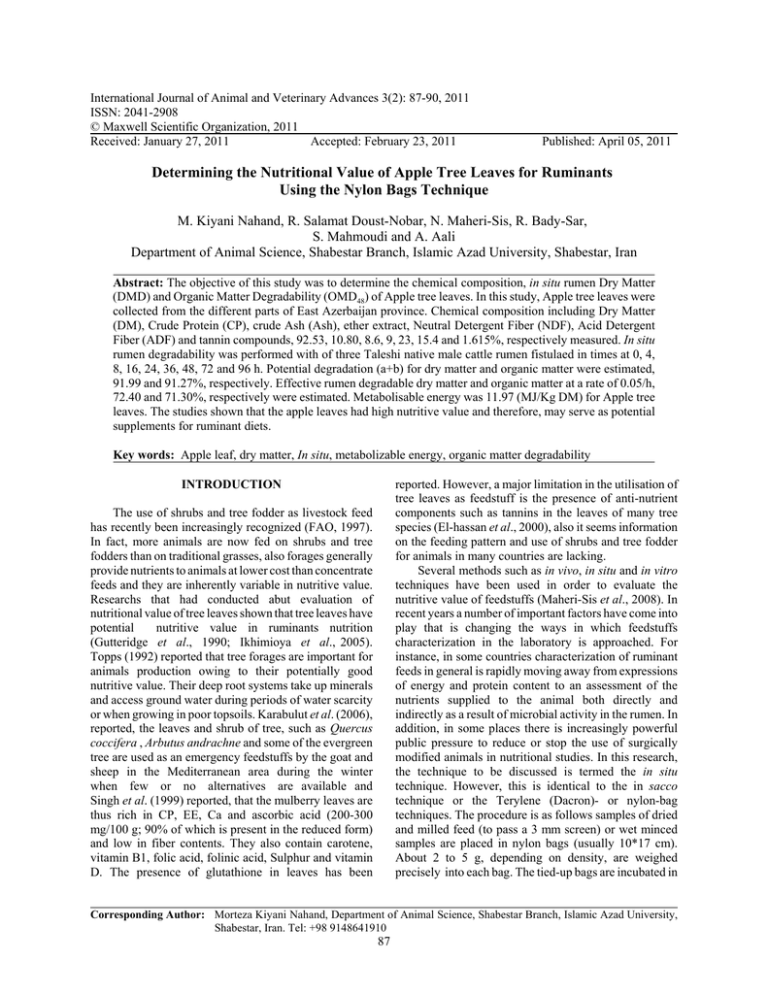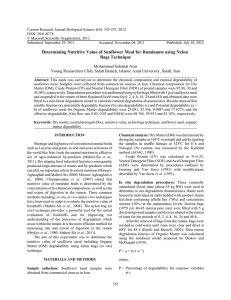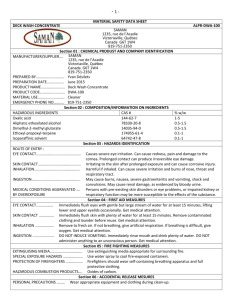International Journal of Animal and Veterinary Advances 3(2): 87-90, 2011
advertisement

International Journal of Animal and Veterinary Advances 3(2): 87-90, 2011 ISSN: 2041-2908 © Maxwell Scientific Organization, 2011 Received: January 27, 2011 Accepted: February 23, 2011 Published: April 05, 2011 Determining the Nutritional Value of Apple Tree Leaves for Ruminants Using the Nylon Bags Technique M. Kiyani Nahand, R. Salamat Doust-Nobar, N. Maheri-Sis, R. Bady-Sar, S. Mahmoudi and A. Aali Department of Animal Science, Shabestar Branch, Islamic Azad University, Shabestar, Iran Abstract: The objective of this study was to determine the chemical composition, in situ rumen Dry Matter (DMD) and Organic Matter Degradability (OMD48) of Apple tree leaves. In this study, Apple tree leaves were collected from the different parts of East Azerbaijan province. Chemical composition including Dry Matter (DM), Crude Protein (CP), crude Ash (Ash), ether extract, Neutral Detergent Fiber (NDF), Acid Detergent Fiber (ADF) and tannin compounds, 92.53, 10.80, 8.6, 9, 23, 15.4 and 1.615%, respectively measured. In situ rumen degradability was performed with of three Taleshi native male cattle rumen fistulaed in times at 0, 4, 8, 16, 24, 36, 48, 72 and 96 h. Potential degradation (a+b) for dry matter and organic matter were estimated, 91.99 and 91.27%, respectively. Effective rumen degradable dry matter and organic matter at a rate of 0.05/h, 72.40 and 71.30%, respectively were estimated. Metabolisable energy was 11.97 (MJ/Kg DM) for Apple tree leaves. The studies shown that the apple leaves had high nutritive value and therefore, may serve as potential supplements for ruminant diets. Key words: Apple leaf, dry matter, In situ, metabolizable energy, organic matter degradability reported. However, a major limitation in the utilisation of tree leaves as feedstuff is the presence of anti-nutrient components such as tannins in the leaves of many tree species (El-hassan et al., 2000), also it seems information on the feeding pattern and use of shrubs and tree fodder for animals in many countries are lacking. Several methods such as in vivo, in situ and in vitro techniques have been used in order to evaluate the nutritive value of feedstuffs (Maheri-Sis et al., 2008). In recent years a number of important factors have come into play that is changing the ways in which feedstuffs characterization in the laboratory is approached. For instance, in some countries characterization of ruminant feeds in general is rapidly moving away from expressions of energy and protein content to an assessment of the nutrients supplied to the animal both directly and indirectly as a result of microbial activity in the rumen. In addition, in some places there is increasingly powerful public pressure to reduce or stop the use of surgically modified animals in nutritional studies. In this research, the technique to be discussed is termed the in situ technique. However, this is identical to the in sacco technique or the Terylene (Dacron)- or nylon-bag techniques. The procedure is as follows samples of dried and milled feed (to pass a 3 mm screen) or wet minced samples are placed in nylon bags (usually 10*17 cm). About 2 to 5 g, depending on density, are weighed precisely into each bag. The tied-up bags are incubated in INTRODUCTION The use of shrubs and tree fodder as livestock feed has recently been increasingly recognized (FAO, 1997). In fact, more animals are now fed on shrubs and tree fodders than on traditional grasses, also forages generally provide nutrients to animals at lower cost than concentrate feeds and they are inherently variable in nutritive value. Researchs that had conducted abut evaluation of nutritional value of tree leaves shown that tree leaves have potential nutritive value in ruminants nutrition (Gutteridge et al., 1990; Ikhimioya et al., 2005). Topps (1992) reported that tree forages are important for animals production owing to their potentially good nutritive value. Their deep root systems take up minerals and access ground water during periods of water scarcity or when growing in poor topsoils. Karabulut et al. (2006), reported, the leaves and shrub of tree, such as Quercus coccifera , Arbutus andrachne and some of the evergreen tree are used as an emergency feedstuffs by the goat and sheep in the Mediterranean area during the winter when few or no alternatives are available and Singh et al. (1999) reported, that the mulberry leaves are thus rich in CP, EE, Ca and ascorbic acid (200-300 mg/100 g; 90% of which is present in the reduced form) and low in fiber contents. They also contain carotene, vitamin B1, folic acid, folinic acid, Sulphur and vitamin D. The presence of glutathione in leaves has been Corresponding Author: Morteza Kiyani Nahand, Department of Animal Science, Shabestar Branch, Islamic Azad University, Shabestar, Iran. Tel: +98 9148641910 87 Int. J. Anim. Veter. Adv., 3(2): 87-90, 2011 Table 1: The chemical composition of apple tree leaves (%) Apple tree leaves Dry matter 92.53 Crude protein 10.80 Neutral Acid detergent detergent fiber fiber 23 15.4 Ash 8.6 ether extract 9 Condensed tannin 1.61 Nitrogen free extract 48.6 Metabolizable energy (MJ/Kg DM) 11.97 were incubated in the rumen of three canulated cattle. Nylon bags were withdrawn at 0, 4, 8, 16, 24, 36, 48, 72 and 96 h after insertion. For soluble fraction (0h) measurement was obtained by soaking the two bags of sample in warm water (370ºC) for 1 h. The 0 h and incubated bags were then washed with cold water for 15 min in a washing machine and dried for 48 h at 60ºC. The DM degradation data were fitted to the exponential equation p = a+b (1-e-ct) (Ørskov and McDonald, 1979). To determine the degradation characteristics (a, b, a+b, c, ED); where p is the DM degradation at time t, a denotes washing loss (representing the soluble fraction of the feed); b insoluble fraction; c is the rate of degradation of fraction b; ED denotes effective degradability, calculated at an outflow rate of (0.02, 0.05 and 0.08 per h). After incubation, DM and OM degradability (DMD and OMD) for each bag, for each incubation period and for each cattle were calculated separately with formulas suggested by Susmel et al. (1990). Metabolizable Energy (ME) contents of apple tree leaves was estimated using equations given below (Bhargava and Orskov, 1987). the rumen of sheep or cattle on an appropriate diet by suspending them from a rumen cannula. They are then withdrawn after various intervals of time, washed and dried. Degradability of dry matter, nitrogen, energy, etc., can thus be measured against time. The objective of this study is to assess the chemical composition, nutritional composition, in situ digestibility characteristics, Organic Matter Digestibility (OMD) and Metabolizable Energy (ME) of Apple tree leaves. MATERIALS AND METHODS This study was conducted over the period from September 2009 to March 2010 at University of Islamic Azad University, Shabestar branch, Department of Animal Science. Shabestar branch, Shabestar, Iran. Animals: Tree fistulated Taleshi steers (5 years old, about 550 kg weighs) were used for rumen application in nylon bag techniques. The animals feeding twice daily with a diet containing alfalfa hay (60%) and concentrate (40%). ME (MJ/Kg DM) = 2.27563+0.1073*DMD Forage samples: During fall season forage samples from different parts of East Azerbaijan province were collected next, there were drying for one week, and uniform mixture were papered for nutritive chemical. The species of Forage sample was Malus domestica . All samples were then ground in a laboratory mill through a 1 mm screen. where, DMD is rumen dry matter degradability for 48 h RESULTS AND DISCUSSION The chemical composition of Apple leaves shown in Table 1. Chemical composition, including dry matter, crude protein, ether extracts, crude Ash, cell wall, cell wall without hemi cellulose, and tannin compounds 92.53, 10.80, 9, 8.6, 20.2, 13.6, 3.88 and 1.25%, respectively. There are many factors affecting chemical composition and mineral content of concentrate feedstuffs such as stage of growth, maturity, species or drying method, growth environment and soil types (Underwood and Suttle, 1999). Leaf yield varies with the fertility of the soil, irrigation and frequency of plucking of the leaves. The content of total phenols was very low (1.8% as tannic acid equivalent), The dry matter and organic matter degradation (%) of apple tree leaves in different incubation times shown in Table 2 and Fig. 1. The 48 h DM and OM degradation were 90.44 and 89.84. There was a steadily increase in the rumen degrability for over a period of 16 h. In situ degradability characteristic of apple leaves shown in Table 3. The DM and OM degradability from the soluble fraction (a) and Potential degradability (a+b) were, 34.13, 33.02 and 91.99, 91.27%, respectively and Chemical analysi: Dry Matter (DM) was determined by drying samples at 105ºC overnight. Organic Matter (OM) content was determined by ashing in a muffle furnace at 550ºC for 6 h. Nitrogen (N) content was determined using Kjeldahl method (AOAC, 1990). Crude protein was calculated as N*6.25. Crude Fiber (CF) and EE were determined by the methods described by AOAC (1990) and Nitrogen Free Extract (NFE) was determined by difference [100 - (CP + EE + CF + ash)]. Neutral detergent fiber (NDF) and Acid detergent fiber (ADF) were determined by the methods of Van Soest (1991). Total phenolic matter was determined according to the method proposed by butanol-HCl method as described by Makkar et al. (1995). All chemical analyses were carried out in triplicate. In situ nylon bag technique: For determine the in situ degradation characteristics of the samples, 4 g of dry sample milled through a 3 mm screen was weighed in nylon bags (16*8 cm, pore size 45 to 60 um). The bags 88 Int. J. Anim. Veter. Adv., 3(2): 87-90, 2011 Table 2: In situ degrability of peach leaves (%) Incubation times Apple tree leaves 0 4 8 16 DMD 37.80 47.53 61.10 86.60 OMD 36.64 46.63 60.14 86.03 DMD: Dry matter degradability; OMD: Organic Matter degradability 24 88.11 87.81 36 89.10 88.20 48 90.44 89.84 72 90.46 89.86 96 90.84 90.38 Table 3: The parameters of estimated from the In situ degradability of apple leaves Estimated parameters Effective degradability ----------------------------------------------------------------------------------------------------------------Apple treeleaves a b a+b c Lag time 0.02 0.05 0.08 DM 34.13 57.86 91.99 0.096 0.694 82.16 72.40 65.96 OM 33.02 58.24 91.27 0.096 0.678 81.13 71.30 64.83 a: washing losses, soluble or rapidly degradable; This value is the intercept of the degradation curve at time 0 h (%); b = the insoluble but potentially fermentable (%); c = degradability rate (h); a+b = Potential degradability (%) 100 100 90 OM disappearance (%) DM disappearance (%) 90 80 70 60 50 40 80 70 60 50 40 30 30 20 0 10 20 30 40 50 60 Incubation (h) 70 80 90 20 100 0 10 20 30 40 50 60 Incubation (h) 70 80 90 100 Fig. 1: The in situ degradation kinetics of apple tree leaves decreased of 81.13% (k = 0.02) to 64.83% (k = 0.08). Mupangwa et al. (1997) observed ED of DM to decrease as the outflow rate. The rumen bag technique has been used for many years to study the degradation of forages However, the digestibility of a feedstuff is defined by the potential degradability of the material, the rate of degradation of this potentially degradable fraction, and its residence time in the rumen (i.e., its effective degradation) plus digestion after the rumen fermentation in the hind gut. the rate degradability)c (were 0.69 and 0.678/h respectively estimated. The total degradability of the sample is given by a+b which obviously cannot exceed 100. It follows that 100 - (a+b) represents the fraction which will appear to be undegradable in the rumen. If 'a' is positive, then there is a component which is degraded rapidly and/or a component which is soluble, or fine enough to escape from the bags simply by soaking and washing. Whether 'a' represents rapid degradation, or simply washing losses, can be determined with control bags which are simply soaked in water and then washed and dried in the normal way. When a negative value for 'a' is obtained this means that there has to be an initiation period for degradation to start (termed the lag phase). Effective Degradability (ED) of the examined nutrient components were calculated using the outflow rates of 0.02, 0.05 and 0.08/h, according to Ørskov et al. (1980), model: ED = a+[bc/(c+k)] where ED is effective degradability and ‘a’, ‘b’ and ‘c’ are the constants as described earlier in the non-linear equation above and ‘k’ the rumen fractional outflow rates. Effective rumen degradable dry matter and organic matter at a different rate were determine, Effective Degradability (ED) of DM and OM decreased with increase in outflow rates DMD decreased of 82.16% (k = 0.02) to 65.96% (k = 0.08) in the leaves and OMD CONCLUSION Chemical composition and in situ degradability can be considered as useful indicators for the preliminary evaluation of the likely nutritive value of previously Uninvestigated shrubs. As such, they have potential as forage for farmers during the long period of dry season when feed is scarce. Our data in this experiment showed that the DM and OM contents of the apple tree leaves evaluated on the basis of their rumen fermentation kinetics. Also the high percentage of dry matter, organic matter degradation and low percentage of tannin compounds having tested samples. The studies shown that the apple leaves had high nutritive value and therefore, may serve as potential supplements for ruminant diets. 89 Int. J. Anim. Veter. Adv., 3(2): 87-90, 2011 Makkar, H.P.S., M. Blümmel and K. Becker, 1995. Formation of complexes between polyvinyl pyrrolidones or polyethylene glycols and their implication in gas production and true digestibility in vitro techniques. Br. J. Nutr., 73: 897-913. Ørskov, E.R. and P. McDonald, 1979. The estimation of protein degradability in the rumen from incubation measurements weighed according to rate of passage. J. Agri. Sci., 92: 499-503. Ørskov, E.R., F. Hovell and F. Mould, 1980. The use of the nylon bag technique for the evaluation of feedstuffs. Trop. Anim. Prod., 5: 195-213. Singh, B., P. Harinder and S. Makkar, 1999. The potential of mulberry tree follage as an animal feed supplement. Animal Production and Health Section, Joint FAO/IAEA Division. Susmel, P., B. Stefanon, C.R. Mills and M. Spenghero, 1990. Rumen degradability of organic matter, nitrogen and fiber fractions forages. Anim. Prod., 51: 515-536. Topps, J.H., 1992. Potential composition and use of legume shrubs and trees as fodders for livestock in thetropics. J. Agric. Sci. Camb., 118: 1-8. Underwood, E.J. and N.F. Suttle, 1999. The Mineral Nutrition of Livestock. 3rd Edn., CABI Publication, Oxon, UK. Van Soest, P.J., J.D. Robertson and B.A. Lewis, 1991. Methods for dietary fiber, neutral detergent fiber and non-starch polysaccharides in relation to animal’s nutrition. J. Dairy Sci., 74: 3583-3597. REFERENCES AOAC, 1990. Official Method of Analysis. 15th Edn., Association of Official Analytical Chemists WAshington DC., pp: 66-88. Bhargava, P.K. and E.R. Orskov, 1987. Manual for the use of Nylon Bag Technique in the Evaluation of Feedstuffs. Rowett Research Institute, Aberdeen, Scotland, UK. El-hassan, S.M., A. Lahlou Kassi, C.J. Newbold and R.J. Wallace, 2000. Chemical composition and degradation characteristics of foliage of some African multipurpose trees. Anim. Feed Sci. Technol., 86: 27-37. FAO, 1997. Tree foliage in animal nutrition. FAO Animal Health and Production Paper No. 139, FAO, Rome. Gutteridge, R.C., 1990. Agronomic evaluation of tree and shrub species in southeast Queensland. Trop. Grasslands, 24: 29-34. Ikhimioya, I., O.A. Isah, U.J. Ikhatua and M.A. Bamikole, 2005. Rumen degradability of dry matter and crude protein in tree leaves and crop residues of humid Nigeria. Pak. J. Nutr., 4(5): 313-320. Karabulut, A., O. Canbolat, C.O. Ozkan and A. Kamalak, 2006. Potential nutritive value of some mediterranean shrub and tree leaves as emergency food for sheep in winter. Livest. Res. Rural Dev., 18(6). Mupangwa, J.F., N.T. Ngongoni, J.H. Topps and P. Ndlovu, 1997. Chemical composition and dry matter degradability profiles of forage legumes Cassia rotundifolia, Lablab purpureus and Macroptilium atropurpureum at 8 weeks of growth. Anim. Feed Sci. Tech., 69: 167-178. Maheri-Sis N., M. Chamani, A. Sadeghi, A. MirzaAghazadeh and A.G. Abolfazl, 2008. Nutritional evaluation of kabuli and desi type chickpeas (Cicer arietinum L.) for ruminants using in vitro gasproduction technique. Afr. J. Biotechnol., 16: 2946-2951. 90





